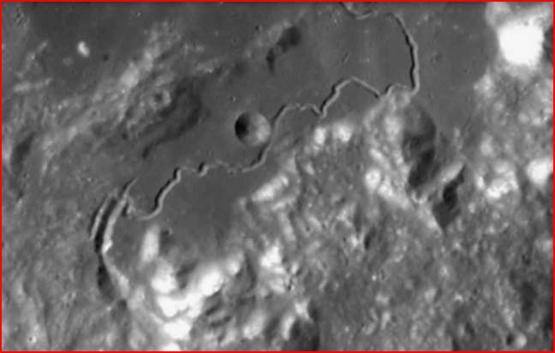- Photo Caption: This SMART-1 picture
of Hadley Rille offers the best look yet at a deep gash cutting across
Hadley (far left).
-
-
- In the history of lunar exploration,
the mysterious association of craters and rilles has provoked a number
of mutually contradictory hypotheses, none of which is sufficient to explain
things seen in high-resolution pictures of the Moon.
-
- In our previous looks at the lunar craters
Tycho and Aristarchus, we observed that the popular "explanation"
(the impact hypothesis) is contradicted by features that, in close-up
photographs, invariably leap out at the critical observer.
-
- Similarly, when we consider details of
the "sinuous rilles" Schroeter's Valley and Hadley, we discover
that common teachings require things that are not there while ignoring
things that are there.
-
- The message conveyed by these prominent
lunar features carries broad implications for our understanding of the
lunar surface at all scales of observation. Our claim has been that theoretical
assumptions in planetary science -- including the most popular teachings
in lunar geology -- cannot withstand a critical review.
-
- Yet there is a vantage point from which
the accumulated anomalies and contradictions disappear. The electric hypothesis
does not arbitrarily separate issues of crater formation from issues of
rille formation. In one instance after another, we see that craters and
rilles stand in a partnership that is far too pervasive to be accidental.
And this convergence is predictable under the electric hypothesis.
-
- Dominating craters on the Moon are surrounded
by non-radial crater chains, irregular concentrations of smaller craters,
sinuous or filamentary channels, and deep gashes -- the very features
seen in electrical arcing experiments and in electrical discharge machining
in industrial applications. To underscore these surface patterns on the
Moon, we have placed two large images of the Euler Crater region here,
http://www.thunderbolts.info/tpod/2006/image06/060321euler-1.jpg, and
here, http://www.thunderbolts.info/tpod/2006/image06/060321euler-2.jpg.
(The files are large -- 1.5mb and 1.8mb respectively -- but they are
worth the look).
-
- The pictures show innumerable small crater
concentrations, crater chains, and gashes, one form merging with another
in every imaginable way. A modest number of the gashes might be mistaken
for impacts at oblique angles, were it not for the repeated instances
in which the gashes are constituted of overlapping craters, or are too
long, or change direction -- attributes that exclude "explanation-by-impact".
In this sense, an unbending adherence to the impact theory can only encourage
theorists to ignore these defining features on the lunar surface.
-
- The standard picture only grows more
incoherent when we consider the numerous rilles and enigmatic channels
that are conventionally "explained" as lava erosion. Why do
they exhibit craters and crater chains of a sort never found in association
with known remains of flowing lava? Look at the higher-resolution image
we presented earlier of the Aristarchus region here, Link: http://www.thunderbolts.info/tpod/2006/image06/060310crater.jpg.
In the lower left of the picture is a rille that divides into twin channels,
both of which end in large craters. Could this anomalous channel have
been formed by flowing liquid of any kind? It is simultaneously a crater
chain and a rille, confirming the point made repeatedly by the electrical
theorist Wallace Thornhill: The same force that produces crater chains
produces rilles.
-
- Rilles often exhibit craters deeper or
wider than the channels on which they are centered. For a good example,
consider the picture of Rima Hyginus here, http://www.thunderbolts.info/tpod/2006/image06/060321hyginus.jpg.
In many instances the larger craters centered on a rille appear at the
"joints" of a meandering channel. Could they be "collapsed
lava tubes," a once-popular hypothesis? It is only necessary to look
closely to see that these formations never reveal rubble from a collapsed
"roof".
-
- Not infrequently, we also observe a secondary
stream of smaller craters meandering down the rille, as we saw along the
floor of Schroeter's Valley. The electrical theorists point to analogs
in both laboratory arcs and in lightning-excavated trenches. On the moon,
a fascinating example is Vallis Alpes, a spectacular channel that extends
some 166 kilometers, cutting across the mountain range Montes Alpes. Clearly,
it was not cut by flowing liquid! See pictures here, http://www.thunderbolts.info/tpod/2006/image06/060321vallis.jpg
and here, http://www.thunderbolts.info/tpod/2006/image06/060321vallis-2.jpg.
Along its mid section it is about 10 kilometers wide. Meandering down
the center of the flat valley floor is a narrow rille punctuated by circular
craters.
-
- Inexplicable gashes emerging from craters
or converging with crater chains are ubiquitous on the lunar surface.
Our picture of Hadley Rille above, recently taken by the ESA SMART-1,
shows an "inexplicable" gash on the far left. The long and deep
gash emerges from the narrow end of a balloon-like crater to cut across
Hadley. It certainly has no explanation in standard theory, and most lunar
scientists simply address it as a "gash" and go on to something
they "understand".
-
- To put all of this in perspective, we
must remember that the craters, rilles, crater chains, and gashes on the
Moon can now be systematically compared to analogs on other bodies to
see whether scientists have been able to forge a coherent interpretation.
We find that, as the quality of the pictures has improved, the interpretations
have grown increasingly fragmented and bizarre. For a telling comparison
of the lunar enigmas to those presented on another body, look at the so-called
"collapse pits" on the Martian "volcano" Arsia Mons,
Link: http://www.thunderbolts.info/tpod/2005/arch05/050607arsamons.htm.
All of the lunar enigmas are there in one place -- craters, crater chains,
gashes, and rilles -- except that here the stunning clarity of the pictures
gives common sense a distinct advantage. Are these formations the result
of "surface collapse", or has material been cleanly removed
from the surface by a force unknown to planetary scientists? In a contest
with the inertia of prior belief, common sense will surely win out in
the end.
-
- Photo Credit: ESA/Space-X
|
